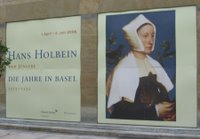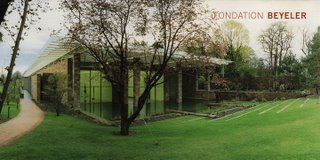 The Fine Art Museum, or Kunstmuseum, has mounted an exhibition of works created by Hans Holbein the Younger during his years in Basel (1515-1532). Considered one of the most significant artists of the 16th Century, Hans Holbein worked here until the restrictions imposed by the Reformation forced him to leave for England where he could express himself more freely. Although he was eventually appointed court painter to King Henry VIII, he dreamed of one day returning to Basel. This exhibition, to be followed in September 2006 by a sister show at the Tate in London focusing on the British years, is a fantastic survey of Holbein's œuvre. From religeous murals to delicate pen and ink drawings of the women of Basel, from exquisitely detailed oil portraits to his mastery of wood and metal cut prints, Holbein's artistic virtuosity is clearly demonstrated here.
The Fine Art Museum, or Kunstmuseum, has mounted an exhibition of works created by Hans Holbein the Younger during his years in Basel (1515-1532). Considered one of the most significant artists of the 16th Century, Hans Holbein worked here until the restrictions imposed by the Reformation forced him to leave for England where he could express himself more freely. Although he was eventually appointed court painter to King Henry VIII, he dreamed of one day returning to Basel. This exhibition, to be followed in September 2006 by a sister show at the Tate in London focusing on the British years, is a fantastic survey of Holbein's œuvre. From religeous murals to delicate pen and ink drawings of the women of Basel, from exquisitely detailed oil portraits to his mastery of wood and metal cut prints, Holbein's artistic virtuosity is clearly demonstrated here. Speeding through the Art History Time Machine, we took a short tram ride to visit the Fondation Beyeler situated in the pastoral town of Riehen, very close to the German border. The great dealer/collector Ernest Beyeler commissioned Renzo Piano to create what I personally consider to be his masterpiece - an absolutely perfect home to Mr. Beyeler's formidable collection of Modern Art. Working in concert with both the location and the art, Renzo Piano has created the ideal viewing situation for the visitor - with the architecture enhancing, rather than overpowering, the art itself.
Speeding through the Art History Time Machine, we took a short tram ride to visit the Fondation Beyeler situated in the pastoral town of Riehen, very close to the German border. The great dealer/collector Ernest Beyeler commissioned Renzo Piano to create what I personally consider to be his masterpiece - an absolutely perfect home to Mr. Beyeler's formidable collection of Modern Art. Working in concert with both the location and the art, Renzo Piano has created the ideal viewing situation for the visitor - with the architecture enhancing, rather than overpowering, the art itself.The Fondation Beyeler features an outstanding permanent collection of Modern Art, with the finest examples of each Modern Master displayed to optimum effect and enhanced with select pieces of Primitive Art to complement the aesthetic. This year's special presentation is "Matisse: Figure, Color, Space" and features 160 paintings, drawings and sculptures representing each phase of Matisse's career. From the early academic works like "Nu à la serviette blanche" (1902), to "Nature Morte à "La danse" (1909) where he explores the perception of space, and on to portraits such as "Portrait d'Olga Merson", 1911, this show seeks to clearly delineate Matisse's artistic evolution. It continues with his great interiors like "Le Paravant Mauresque", 1921, to less patterned, more stylized "Grand nu couché", 1935, and finally his fabulous colorful cut-outs culminating in "Jazz" 1947.
A return visit to Art Basel with a walk-through the ultra-contemporary Art Unlimited section was very amusing. Here, in this enormous exhibition space where one can easily imagine a convention of farm equipment, for example, are site-specific installations by some of the hottest names in today's art scene. My favorite was "bit.fall" by Julius Popp, a young German artist who uses the medium of falling water as an "ephemeral information-curtain as a metaphor for the incessant flood of information we are exposed to and from which we draw our perpertually changing realities...". However formally you want to express it - the bottom line is it was mesmerizing and very popular.
For several years now, the month of June has involved a trip to Basel and the Art Fair. It is always a fascinating and wonderful show filled with delights both artistic and collegial. This year was no exception. To be able to combine great art with a celebratory lunch with friends on a terrace overlooking the Rhine makes me feel very lucky indeed.
Our time in Switzerland is almost over. Next stop - the South of France!


No comments:
Post a Comment